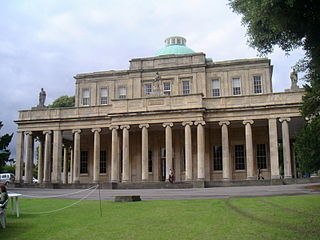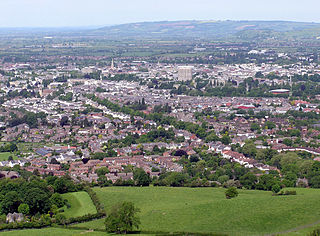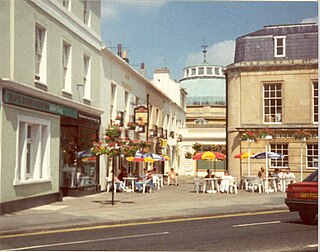
Regency architecture encompasses classical buildings built in the United Kingdom during the Regency era in the early 19th century when George IV was Prince Regent, and also to earlier and later buildings following the same style. The period coincides with the Biedermeier style in the German-speaking lands, Federal style in the United States and the French Empire style. Regency style is also applied to interior design and decorative arts of the period, typified by elegant furniture and vertically striped wallpaper, and to styles of clothing; for men, as typified by the dandy Beau Brummell, for women the Empire silhouette.
Henry Edmund Goodridge was an English architect based in Bath. He worked from the early 1820s until the 1850s, using Classical, Italianate and Gothic styles.
The Playhouse Theatre Cheltenham is a community theatre in Cheltenham, United Kingdom. It is a registered charity and has been run by volunteers since 1957. Built in 1806 by Henry Thompson, the theatre started life as the Montpellier Baths. The building was converted to a swimming pool in 1898 and then to a theatre in 1945.

Pittville is a residential suburb of Cheltenham, Gloucestershire, England, founded in the early 19th century by Joseph Pitt. The population of Pittville Ward at the 2011 Census was 5,327. It now contains Pittville Park, with its two lakes, skatepark, three cafes, tennis courts, menagerie, children's play area, 9-hole pitch and putt golf course, and Pump Room, and Pittville School. The upmarket tone of the area is set by the architecture: Pittville contains some of the finest examples of Regency and Victorian housing in the town. Gustav Holst's father, Adolph von Holst was organist at All Saints' Church, Pittville.
Samuel Whitfield Daukes or Dawkes (1811–1880) was an English architect, based in Gloucester and London.
John Pinch the elder was an architect working mainly in the city of Bath, England. He was surveyor to the Pulteney and Darlington estate and responsible for many of the later Georgian buildings in Bath, especially in Bathwick. His son, John Pinch the younger, was also an architect and surveyor to the Pulteney and Darlington estate. His daughter, Celia Pinch, married the silversmith William Holme Twentyman on Mauritius.

The Pittville Pump Room was the last and largest of the spa buildings to be built in Cheltenham.
John Palmer was an English architect who worked on some of the notable buildings in the city of Bath, Somerset, UK. He succeeded Thomas Baldwin as City Architect in 1792. He died in Bath.

Cheltenham Minster, St Mary's is a minster and the parish church of Cheltenham.

Amon Henry Wilds was an English architect. He was part of a team of three architects and builders who—working together or independently at different times—were almost solely responsible for a surge in residential construction and development in early 19th-century Brighton, which until then had been a small but increasingly fashionable seaside resort on the East Sussex coast. In the 1820s, when Wilds, his father Amon Wilds and Charles Busby were at their most active, nearly 4,000 new houses were built, along with many hotels, churches and venues for socialising; most of these still survive, giving Brighton a distinctive Regency-era character, and many are listed buildings.

Montpellier Rotunda is a Grade I listed building in Montpellier, Gloucestershire, England. It is now the Cheltenham restaurant in The Ivy Collection..

Buxton Crescent is a Grade-I-listed building in the town of Buxton, Derbyshire, England. Owing much to the Royal Crescent in Bath, but described by the Royal Institution of British Architects as "more richly decorated and altogether more complex", it was designed by the architect John Carr, and built for the Fifth Duke of Devonshire between 1780 and 1789.

Montpelier is an inner suburban area of Brighton, part of the English city and seaside resort of Brighton and Hove. Developed together with the adjacent Clifton Hill area in the mid-19th century, it forms a high-class, architecturally cohesive residential district with "an exceptionally complete character". Stucco-clad terraced housing and villas predominate, but two of the city's most significant Victorian churches and a landmark hospital building are also in the area, which lies immediately northwest of Brighton city centre and spreads as far as the ancient parish boundary with Hove.
Henry Skillicorne (c1678-1763) was a Manx-born merchant mariner who after some four decades trading out of Bristol began a second career as the first serious developer of the spa waters in Cheltenham. Regarded as 'the founder of Cheltenham as a watering place' in all the standard histories of the town, his memorial inscription in the parish church, standing at 53 lines and almost 600 words, is one of the longest in Britain, and has been transcribed and reproduced many times.
Richard Lockwood Boulton was an English sculptor who founded the firm Messrs R. L. Boulton & Sons. They were centred in Cheltenham, England, and built monuments made of iron and stone in the United Kingdom.

Isaac Thomas Shutt was an architect, a farmer, and the proprietor of the Old Swan Hotel, Harrogate, North Yorkshire, England, from 1849 to 1879. In 1842, at the age of 24 years, he designed the Royal Pump Room, Harrogate, now a Grade II* listed building. In partnership with Alfred Hill Thompson he co-designed the Church of All Saints, Harlow Hill.



















